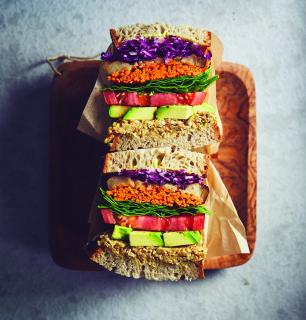sourdough starter: The baker’s Holy Grail
“When a baker uses yeast, it’s like taking the highway to get somewhere. It’s fast, easy and predictable. It doesn’t take a lot of effort. Using a sourdough starter is like taking the country roads, knowing that there will be a handful of detours before you get where you’re going. It takes longer and is prettier, but requires more attention. Both are justifiable and aren’t necessarily contradictory. It comes down to a question of values and preferences.”
This is the view of Laurent Gaudré, a consummate bread lover and genuine authority on the subject of sourdough starter (also called pre-ferment or leaven) at Première Moisson. After handling dough in nearly 30 countries, the French baker decided to settle in Quebec, and he’s been here for seven years now. “There’s quite a bit of confusion around yeasts and starters,” he notes. We’re going to try to straighten it all out here.
Yeast is relatively straightforward. You can find it fresh, usually in a solid block, but most often, you see it dried, in a jar or packet, with a texture that somewhat resembles cornstarch. This “instant yeast” is added directly during the kneading process when the water is mixed with the flour. These super-active yeasts are microscopic mushrooms. Their job is to transform some of the starch in flour into carbon dioxide and ethanol – this is fermentation – which causes the dough to rise. At Première Moisson, most of our daily loaves are made using our small slabs of fresh yeast.
A sourdough starter is a very basic mix of flour and water. But in just a few days and in favourable conditions – warmth and humidity – the mixture metamorphoses into a fascinating hotbed of harmonious and constantly shifting wild yeasts and bacterial cultures that come from the air, the flour and the water. The ecosystem of the starter stems from somewhat mysterious science, since each artisan interacts with the medium a bit differently. The goal isn’t to control it but to understand it, tame it and anticipate its behaviour.
By its very definition, a starter culture is life. It contradicts the spirit of our industrial era. So much of the identity of the person tending the starter goes into it that many people name theirs: Albert, Hazel, Winnifred. I know a baker who brings his starter on vacation because he’s afraid to leave it in someone else’s hands.
It only takes a few minutes to start a sourdough, but if we take very good care of it, it will outlast us. Calling this relationship a love affair would not be off base. After giving birth to the starter, we feed it and let it rest. A starter requires time, discipline, attention, intuition and some devotion. It sometimes needs a slight correction as it grows, to bring it back to the straight and narrow. Give to it and it will give back in spades.
The starter plays a fundamental yet subtle role in influencing the bread’s texture, colour, scent, flavour and shelf life. While the grain is the main vehicle of taste in good bread, fermentation is a close second. The starter highlights the grain’s taste and amplifies it, while adding a delicate, tangy taste. It helps form a crisp armour of crust that keeps the bread fresh and tender. The slight acidity delays staleness. In fact, sourdough bread is often better a day or two after it is baked.
Sourdough starter needs time to perform well. During this time, enzymes naturally break down some of the complex carbohydrates. This slow process is what makes sourdough bread easier to digest. Fermentation begins the work, and the stomach finishes it with less effort.
Recent European studies have shown that wheat bread made with sourdough starter may be suitable for people who are intolerant to gluten. The problematic molecule seems to be modified enough by fermentation that it loses its negative effects.
In short, the longer the fermentation period, the richer and more complex the flavour of the bread, and the more digestible it will be. Long before Pasteur discovered yeasts, our ancestors were making huge bread loaves and baking them for an hour and a half in very hot ovens, almost to the point of burning them. They clearly understood the process.
Laurent relates this interesting tidbit: “I wasn’t there so I can’t guarantee it, but there’s good reason to believe Première Moisson’s starter is a 1992 vintage, from the year the first bakery opened, since it’s the practice to set aside some of the starter after each batch. Theoretically, every sourdough bread we bake encases a tiny spark from co-founder and baker Bernard Fiset. Our current bakers add their own DNA to his: even as they follow our strict protocols, a tiny piece of their identity ends up in the starter. This is why the sourdough loaves at our different bakeries might be slightly different even if we use the same recipe.”
Occasionally, a customer will ask at the counter how much a little bit of sourdough starter would cost. “It’s priceless!” says Laurent. “But at the same time, it’s worth very little, since it’s just flour and water. But it’s also been nurtured through 27 years of daily love and care!”
Sourdough starter is a story that is passed down. It’s the art of authenticity. It’s know-how, knowledge, intrigue, a healthy dose of intuition and passion. Another sourdough fanatic once told me, “When bakers give away a little of their starter, they’re also giving part of themselves, their time and energy. They only give it to someone once. If cared for, the starter will keep on giving. If it dies, the receiver didn’t deserve having it.”
Our recipes
See all recipes




